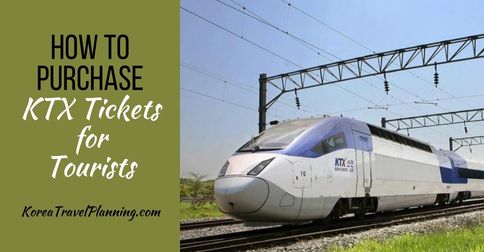When you first start planning your visit to South Korea, a common question is what are the Korea transportation options. This article provides an overview of the various transportation options for tourists, which includes flights, trains, buses and ferries to help you plan your visit, as well as transportation pass options.
Public transportation in Korea is mostly quite easy to work out as the system is all run by the government, and English signage is common. We personally do not speak any Korean, and found it relatively easy to get around, but it is definitely worthwhile to do your homework in advance!
Don’t miss out on the opportunity to make your trip planning easy, hassle-free and organized. Click here to download your FREE printable checklist, to help you to plan your trip step by step and tick off items as you finalise your preparations.Join the South Korea Travel Planning Facebook Group
You are also welcome to join our South Korea Travel Planning Facebook Group – it is a great resource to enable you to ask questions about your upcoming trip to South Korea!
Disclaimer: This article contains affiliate links. If you book after clicking on one of these links then we may receive a small commission at no extra cost to you.
About South Korea
Below is a map showing our recommended best places to visit in Korea for tourists. You can read our detailed article to learn more about each of these destinations.
Korea Transportation Card
The main local transport cards are a Railplus Transport card or the T-money card. Another option is the Cashbee card for use in Busan, however you can use your either the Rail Pass Plus and T-money cards in Busan and all for all other local transport within cities throughout South Korea. You can purchase and load credit to your local transport card at any convenience store or train station.
All three transport card options are rechargeable smart cards that can be used to pay for bus and train/subway fares as well as for taxis displaying the T-money or Cashbee logo. One of the many benefits of using a rechargeable smart card is that the fares are discounted compared to paying for the fare with cash. They can also be used to make payments at places such as convenience stores.
The transport cards are very easy to use, you just tap on and off as you go and recharge your credit as required with cash only. You can easily obtain a refund of your remaining credit before departing from South Korea at convenience stores and train stations.
Note that when you travel between cities in South Korea either by train or bus, you will need to separately purchase your ticket.

Korea Public Transport Apps
South Korea is unique as you cannot use Google Maps to easily get around like you can in most other countries – it shows most public transport options from station to station but cannot show the walking or driving sections.
Our preferred app to use is KakaoMap (Google Play Store and Apple App Store) – we do not speak Korean and were able to use this app to easily get around all of South Korea on public transport and when walking. It shows various route options, which includes transport times, public transport fares, and which Subway or bus lines to catch.
There is an option to set your language to English. It is a good idea to set up and save your planned destinations to the app to make it easier to use while you are out and about. You can easily search for where you want to go – it does not auto fill destinations, so you may need to have a go at typing it in, press search and then relevant options will appear to choose from.
Click here to check out our detailed article on recommended apps for your visit to South Korea
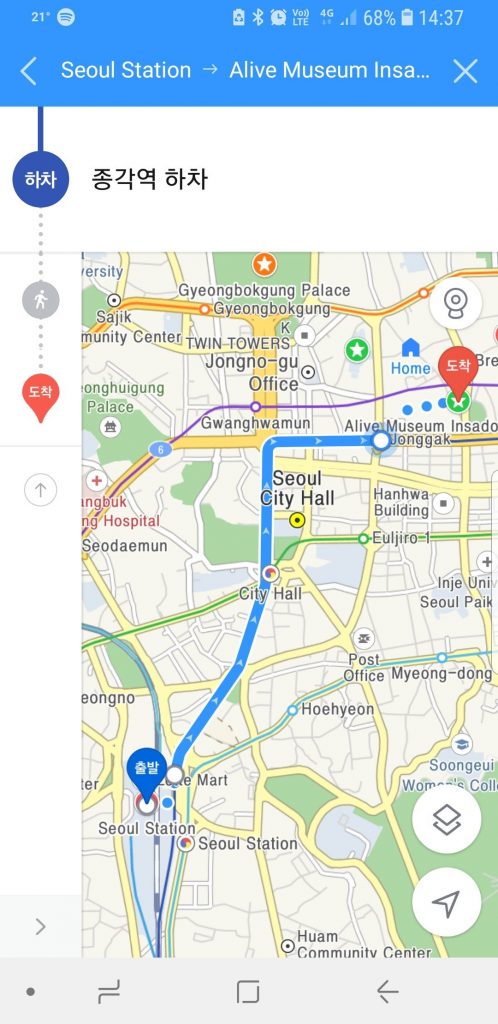
Getting around Seoul, Busan and other cities
You can easily get around Seoul, Busan and other cities in South Korea using either the local Subway or bus system. For more detailed information about the Seoul Subway system check out our detailed article to help tourists get around Seoul.
For local public transportation options, just use Kakao Map app as detailed above and you will quickly see all public transportation options to travel between places, which can include a combination of subway and bus options, depending on what options are available in that location.
Intercity Public Transportation in Korea
For intercity public transport in Korea you have options including trains, buses and ferries. Below is an overview of each option.
Trains in Korea
Korea has an extensive network of Korean bullet trains, which are called the KTX Train Network and operate at speeds of up to 305 km/h / 190 mi/h, which are operated by Korail, the government owned train operater across all of South Korea.
Additional slower train services are provided on the same lines by the ITX, Mugunghwa and Super Rapid Transit (SRT) trains. A basic philosphy is that the slower the train, the cheaper the ticket. As a quick comparison, to catch a KTX train from Seoul to Busan will take 2:15 hours and cost approximately $US53. A slower train option may take almost 6 hours and cost $US26.
Each line operates from one of three KTX stations in Seoul – Seoul Station on the western side of Seoul, Yongsan Station on the southern side of Seoul and Cheongnyangni Station on the eastern side of Seoul. Suseo Station in Gangnam (on the souther side of Seoul) is another starting point to use the SRT trains, which then connect with the KTX. So ensure when you research train options that you also consider your departure point.

Korea Train Map
You can see the detailed Korean train map below which shows the KTX lines. Note that there are additional scenic train lines which do not show on this map, which are further detailed below.
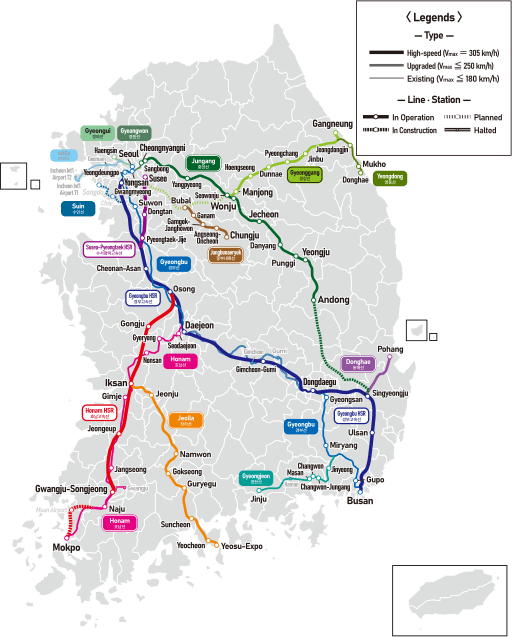
Tourist Trains in Korea
There are several scenic train options in South Korea as detailed below, all can be booked through the Korail website. Note that many of the tourist trains stopped operation due to COVID19, and there is limited information available about when they may restart services.
- The S-Train is the ‘Sea Train’ which travels along the southern and eastern coast of Korea. There are two separate lines, one from Busan Station to Yeosu Station, and the second line from Gwangju to Masan. The train timetables are set up to enable you to transfer between trains at Hadong Station. Total travel time for the full route is approximately 5.5 hours.
- The V-Train is the ‘Baekdudaegan Mountain Range Canyon Train’ which departs from Buncheon Station to Cheoram Station and return. The one way trip is just over one hour long at a slow pace to enjoy the scenery.
- The O-Train is the ‘Central Inland Region Train’ which departs from Yongsan Station in Seoul and travels a loop route of 250km / 155 mi over a 5 hour period. This is a great option to explore central Korean mountain landscapes. There are many stops along the way if you want to explore further.
- The A-Train is the ‘Jeongseon Arirang Train’ which departs from Cheongnyangni Station to travel to Auraji Station to enjoy beautiful views along the way, also with the option to visit the traditional Jeaongseon market which is held weekly.
- The G-Train is the ‘West Sea Gold Train’ which departs from Yongsan Station in Seoul and travels one way along the beautiful west coast to Iksan Station over 3.5 hours. The train has many amenities to enjoy for which you pay a separate fee. Note that one of our readers recently travelled on this service, and found that the train did not have the additional amenities advertised, and overall had a disappointing experience.
How to Book Intercity Train Tickets in Korea
There are a couple of options to book intercity train tickets. For tourists we recommend you pre-book your tickets as early as possible to ensure that you get your preferred train option. You can easily search for and book your tickets online through the Trip.com website.
Check out our detailed article on How to Purchase KTX Tickets for Tourists (includes step by step details on how to book either direct or when purchasing a Korail pass)
Korail Pass
A 2, 3, 4 or 5 day Korail pass (a special rail pass for visitors) is a great option for visitors when travelling to South Korea. You can choose either consecutive days or flexible days within a 10 day period when purchasing your pass. If you are travelling as group you can also access additional savings for groups of 2-5 people. The Korail Pass can be used on all intercity trains with the exception of SRT trains, and also includes the tourist trains.
A Korail pass comes with a range of other benefits including free or discounted entry to a range of museums, attractions and tours as well as discounts for a range of hotels and duty-free shops. A big feature of the Korail Pass is that it makes it very easy to change your seat reservations on the go without having to seek ticket refunds.
Click here to check out and book your instant confirmation Korail Pass through Klook
Klook.com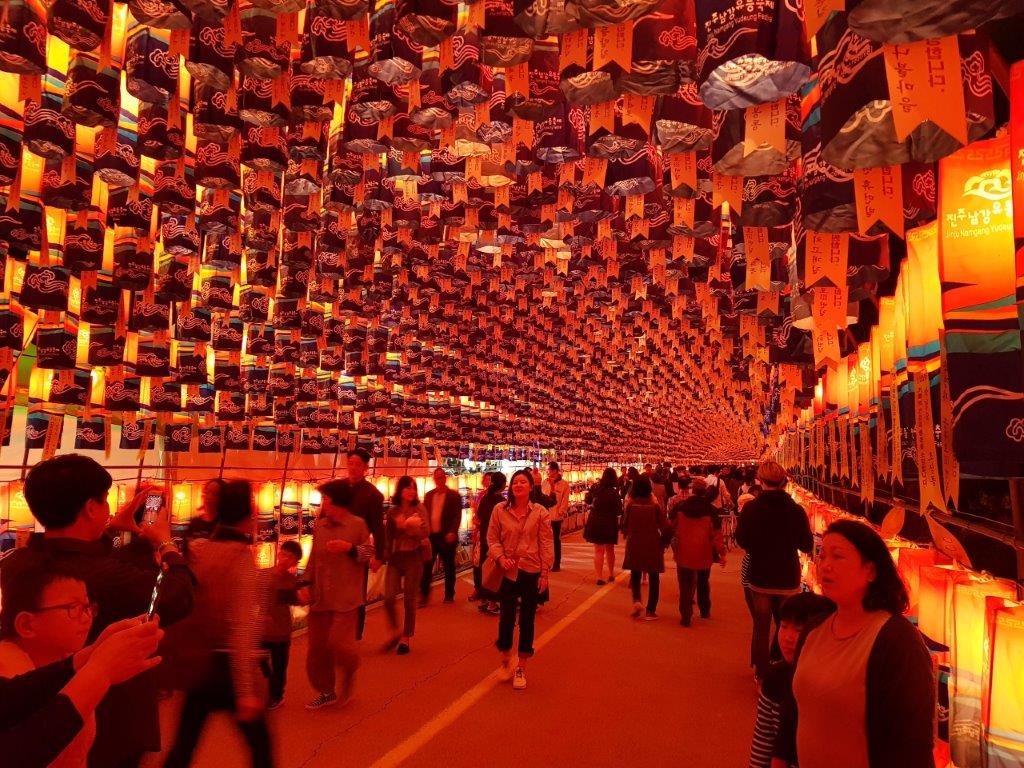
Intercity Buses in Korea
There is also a vast network of intercity bus options in South Korea to consider when getting around. The buses are clean, fast and a great option to get around more directly between locations when a direct train option is not available.
There are two separate Korean bus networks – Express Buses and Intercity Buses. In each location they usually have separate bus terminals, so when planning your trip carefully check the departure and arrival locations.
Express Buses run direct on expressways and typically on make stops at rest areas. Express Buses have regular/standard and luxury level options, along with late night services. Express Bus tickets can be booked using the Bustago website.
Intercity buses travel from one region to another, and are more likely to make stops along the way. Direct route options can also be available. Intercity Bus Tickets can be booked using the Kobus website. Both booking apps can have issues if you do not speak Korean, so you are better off going to the website instead, and make sure you also download your e-ticket after making your booking.
The easiest way to work out which bus service to use is through the KakaoMap app or website, where you will be able to see all of the schedules and options. Ensure you carefully enter your departure and arrival addresses to see the different transport options available.
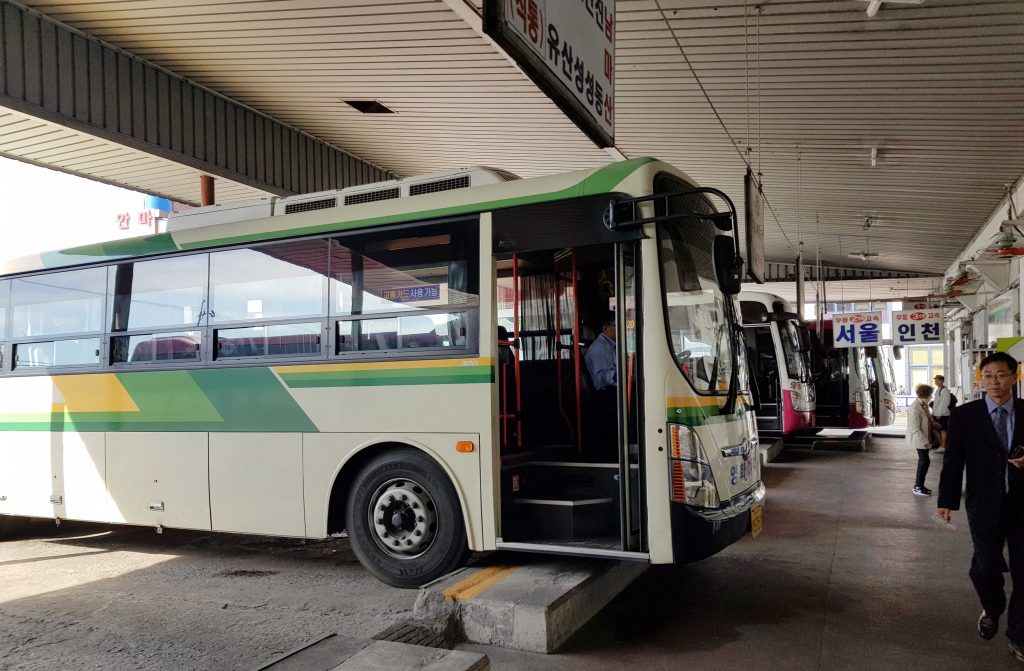
Flights in Korea
For international arrivals and departures, you can plan to use any of Incheon Airport and Gimpo Airport in Seoul, Jeju Airport, Gimhae Airport in Busan and many more.
There are also a large number of internal flight options in South Korea, with many budget options to get around more easily. When considering these options ensure you also consider the additional transport to and from each airport, as well as the time required. Usually a train or bus may take less time overall!
In Seoul there are two airports, Incheon and Gimpo Airport. Most common tourist locations within South Korea that you can fly to include Jeju Island, Busan and Daegu. All internal flight times are less than 1.15 hours.
My preferred option to look for flights is using Google Flights, as it includes all low cost airlines. Once you have worked out which flights you are interested in, my recommendation is to book your flight directly through that airline as it makes it easier to resolve any issues which arise.
Ferries in Korea
You can also easily travel between South Korea and Japan by the fast ferry service between Busan Port and Hakata Port in Fukuoka Japan.
Jeju Island is only accessible by either a flight or a ferry. Many cheap flight options are available. The ferry options are as follows:
- Incheon (Seoul) to Jeju Island Ferry. An overnight trip typically departs at 7pm and arrives on Jeju island at 9.30am with 14.5 hour travel time. The return trip departs Jeju at 7.30pm/8.30pm and arrives in Incheon at 9am/10am. Departs on this route every 2 days.
- Busan to Jeju Island Ferry. An overnight trip, typically departs at 7pm and has a 12 hour travel time, departs every 2 days.
- Mokpo to Jeju Island. A daytime trip, typically departs in both morning and afternoon most days and has a 4.5 hours travel time.
- Nokdong (Goheung) to Jeju Island. A daytime trip, typically departs once per day and has a 3.5 hour travel time.
- Yeosu to Jeju Island. An overnight trip, typically departs at 1.30am and has a 6 hour travel time, departs daily.
The easiest option to find and book your ferry trip is through the DirectFerries.com website, with the exception of the Incheon to Jeju service.
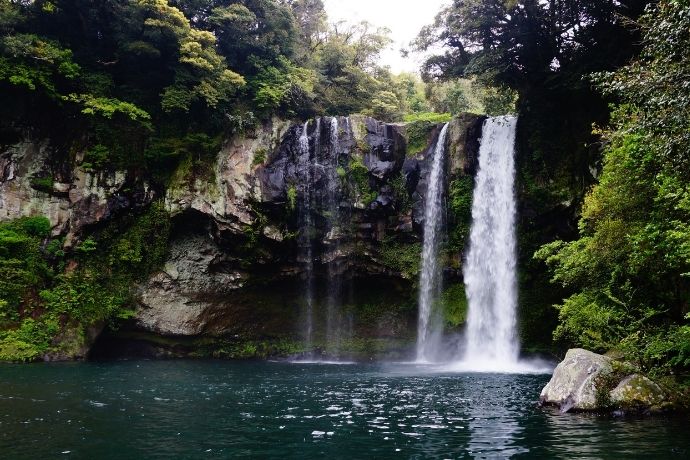
Driving in Korea
Another option to get around Korea is to drive yourself in a rental car. In Korea you drive on the right hand side of the road.
You will need to obtain an International Drivers Permit (IDP) before you depart your home country – it is basically a translation of your drivers licence.
Make sure you book a car with an included GPS and tolls, and ask the staff to help you change it from Korean to English. Also ensure you plan ahead for car parking – look for accommodation with an included car park or readily available alternative parking options.
Klook offers a great car hire option for both Seoul and Jeju Island – which include a variety of car sizes
Don’t miss out on the opportunity to make your trip planning easy, hassle-free and organized. Click here to download your FREE printable checklist, to help you to plan your trip step by step and tick off items as you finalise your preparations.Join the South Korea Travel Planning Facebook Group
You are also welcome to join our South Korea Travel Planning Facebook Group – it is a great resource to enable you to ask questions about your upcoming trip to South Korea!
Disclaimer: This article contains affiliate links. If you book after clicking on one of these links then we may receive a small commission at no extra cost to you.
Anne Sutherland-Smith is a seasoned travel writer and a passionate explorer of South Korea’s vibrant culture, history, and landscapes. With decades of travel experience, Anne deeply understands what makes Korea a unique and captivating destination for travelers worldwide. As the lead author for koreatravelplanning.com, Anne’s work is based on thorough research and firsthand experiences. Her insights are regularly sought after in the travel community, and she has been featured in various travel forums and publications. Her expertise extends to Korean destinations, transportation, cuisine and the latest trends in Seoul’s bustling city life.
Dedicated to providing reliable and practical travel advice, Anne ensures that every piece of content on koreatravelplanning.com is accurate, up-to-date, and useful for travelers at every stage of their journey. Her commitment to authenticity and her personal experiences traveling across Korea make her a trusted voice in the travel community.
Follow Anne’s adventures and get valuable Korea travel tips on koreatravelplanning.com and through her social media channels. Whether you’re planning your first trip to Korea or looking to explore deeper, Anne’s insights will be your invaluable guide.


